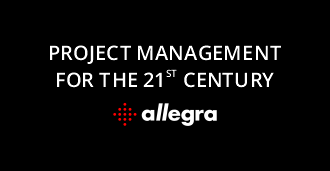4 Task Management Methods You Need to Know
Overview
In this article, we will take a look at which four task management methods will help your team work smarter, not harder. Quality task management systems, such as Allegra, support all four of these methods.
1. The Eisenhower Method
A manager is not only responsible for his or own task management, but also that of his or her employees. Task prioritization is a critical aspect of task management. Usually, managers assign only high-priority tasks to themselves, since they likely do not have the time to handle low-priority ones. However, sometimes a task’s priority is unclear, so managing it is difficult.
One of the most helpful task management methods, the Eisenhower Method, is named after a quote attributed to U.S. President Dwight D. Eisenhower: “I have two kinds of problems, the urgent and the important. The urgent are not important, and the important are never urgent.”
Important or Urgent?: An Essential Question in Task Management
According to the Eisenhower Method, we must distinguish between the importance and urgency of a task. This helps us focus on what is really important.
The combination of importance and urgency results in its priority. The Eisenhower Matrix, as shown below, arranges pending tasks into four priorities:
- important and urgent
- important but not urgent
- not important but urgent
- neither important nor urgent
Task Urgency
An urgent task must be taken care of right away, or it is perceived as such. Here is an everyday example: Most people pick up the phone as soon as they see it ringing, whether or not they are in the presence of company. If a customer calls you, it’s unlikely that you would answer the phone and say, “I will call you back in 15 minutes. I need to talk to my coworker.” However, you probably have no problem with letting your coworker stand by for 15 minutes as you attend to the customer. You can finish talking to your coworker afterwards.
Urgent tasks are usually highly conspicuous. They jump out at us, just like when the phone rings. Everyone understands when we turn our attention to them because they need to get done now, or appear as such. However, despite their appearance, sometimes they are completely unimportant. In the scenario above, it might have been more important to speak with your coworker right away. This is why we need to focus on importance as well as urgency in task management.
Unimportant but urgent tasks can be tricky. We believe these tasks must be completed quickly so that we maintain an appearance of importance. Nevertheless, these tasks have little to do with achieving our crucial goals.
Task Importance
First and foremost, tasks are important because they are consequential. If something is important, then it contributes to the achievement of our goals. Ordering tasks by importance always has something to do with results. Unfortunately, we can easily forget or postpone important things that are not urgent.
It is common to put off important things if they are not urgent. While we respond to urgent tasks reactively, we must proactively address important yet non-urgent tasks. This requires practice and a certain mindset.
Important and urgent tasks are also known as crises or problems. Crisis managers and deadline-driven problem managers spend a large part of their time on this type of task. Not only are these tasks critical for a certain result, but they must be completed as soon as possible.
2. The RACI Matrix
The RACI matrix, RACI method, or Responsibility Assignment Matrix (RAM) is one of the most underrated task management methods. It breaks down the usual “agent” role in project management into three additional roles. This allows an employee to have other relationships to a task, rather than just being generally accountable for it. When employees need to know when a task is complete, or someone’s knowledge is required to complete a task, no one is left looking for answers with RACI.
The RACI method does not replace other techniques such as project plans, Gantt charts, or network diagrams, but it complements them.
RACI’s Four Operation-Specific Roles
The RACI method defines four operation-specific roles for project participants. Normally, we assign general roles, but not for the operation of certain aspects of a task. For example, your company names one project manager to take care of a project. But how do we know which team members are responsible for performing a given task? Who is accountable for it? What if someone needs a hand? Does anyone need to be kept in the loop about decisions being made? RACI gives us answers to these questions, since it lets us assign roles on an operation-specific basis.
To get more specific, tasks are listed in rows and project members in columns in a RACI Matrix. In the intersection field of task and agent, you can enter the respective role that connects a team member to a task.
The four roles are:
- The Responsible (Agent): Who performs the task?
- The Accountable (Manager): Who makes decisions and takes actions for the task(s)?
- The Consulted: Who is consulted and informed about decisions and tasks?
- The Informed: Who is informed about decisions and actions during the project?
So, in the intersection fields within the matrix, you can enter an R, A, C, or I, or you can leave it empty. For each task, there should be only one R. In other words, there should not be more than one R per line.
RACI presents responsibilities and competencies within a company or project in a clear, differentiated, and concrete manner. Overall, RACI makes task management less contentious, since there are fewer misunderstandings. There are fewer lengthy and fruitless discussions in project meetings, since everyone’s roles and responsibilities are clear and easily accessible. Teams can make effective, quick decisions, while maintaining a fairly-distributed workload.
3. Getting Things Done
Getting Things Done (GTD) is one of the most comprehensive task management methods for personal task management, according to David Allen. As we well know, stuff appears in our thoughts, on our desks, or on our computers during the day. We can also refer to stuff as tasks.
Stuff includes ideas, project tasks, open items, bug reports, and customer requests. A recipient cannot directly influence the inflow of incoming tasks, but he or she can sort them with GTD.
All incoming tasks are first collected in the personal inbox, which is a type of basket. A basket is a folder or other container in a project management software. The tasks received there are analyzed regularly and categorized.
Task Analysis
It is important to analyze and categorize tasks by what action, if any, we need to take to complete them.
We categorize tasks in the following ways:
- A task is “actionable.” Something needs to be done.
- It is “not actionable.” It needs to be noted and possibly filed somewhere, but it is not urgent.
- It requires a sequence of actions. This possibly involves several people over a long period of time, which necessitates planned actions. Scheduled tasks within planned actions can be, for example, a work breakdown structure for a project or a Scrum product backlog.
Actionable Tasks
Actionable tasks are sorted into three baskets:
- Next actions: Here, you can place tasks that you want to work on in the near future. There is no real planning or deadline for next actions. If you have deadlines or dates in mind, then you should place these tasks in the calendar basket.
- Calendar: This is where you can place all time-dependent tasks, such as an appointment or a meeting. The calendar basket contains three types of actions: Appointments, Actions, Day, and Day-specific information.
- Delegated/waiting: This basket contains tasks that you have given to someone else.
Not Actionable Tasks
For not actionable tasks, there are also three baskets:
- Garbage: Tasks here will not be further considered and will be deleted at some point.
- Incubator: Tasks that do not require action at the moment are placed here. They might be considered later, but maybe not. These tasks can serve as the basis for future work. A few examples are ideas, wishes, improvements, etc.
- References/Favorites: This basket contains material that may one day be important or you need to frequently check up on, e.g. FAQ, requirements, standards, etc.
Planned Operations
You should review the basket for planned operations regularly. You can move these operations into one of the actionable baskets, if need be. This helps you keep your plans in sight.
4. Workflow Automation
Workflow automation is a vital aspect of task management. A task management system should allow for automated answers to emails, resubmissions, escalations, approval processes, etc. so that you can spend more time on achieving results.
Conclusion
Tasks are the stepping stones to successful projects. Each of these methods will structure your internal processes, which means wasting less time in important meetings, getting fewer headaches during the day, and achieving better results.



